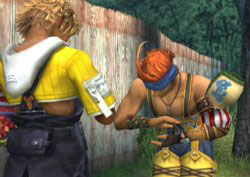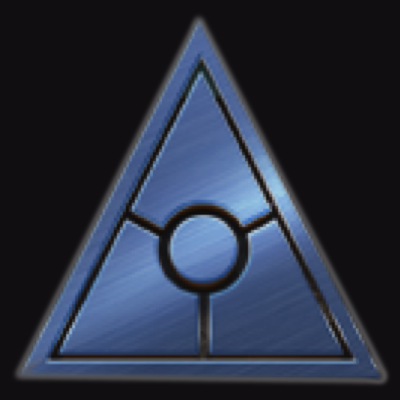Assassin's Creed is an historical science fiction third person action-adventure game series consisting of four main games and a number of supporting materials. Other than a reliance on Templar legends and hidden symbols such as pyramids and apples, there is nothing that references Freemasonry or the Illuminati. This has not prevented mistaken reports based on conspiracy theories.
The object of this game is to complete a series of missions with the intent of contacting and finally joining the Illuminati with the objective of restoring an age-old secret government to rule the world with compassion and an invisible hand.

|
The metaplot of this role-playing game involves a four-way conflict between a science-based Technocracy (Order), insane Marauders (Chaos), cosmically evil Nephandi (Entropy) and nine magical Traditions, to which the player characters are assumed to belong. One of the "traditions", the Sons of Ether, make use of a logo incorporating a compasses, pyramid-like triangle and a stylized all-seeing eye. Sons of Ether (#3), WWP No. 4058 (Tradition Books), Sons of Ether, WWP No. 4658 (Revised Tradition Books). World of Darkness, White Wolf Games, White Wolf Publishing, Inc., Atlanta, Georgia, USA. Originally developed in the late 1980s by Jonathan Tweet and Mark Rein-Hagen.
Used as a compass rosette on a map, the square and compasses has ceased to be viewed as a masonic trademark and has become simply a catchy image, a visual shorthand for the mysterious. Written by R. Hyrum Savage, Chad Cunningham & Christopher T. Miller. Santa Monica : OtherWorld Creations, 2000. pb 112pp.
The main character, Morgan (or Morganna), seeks four ancient objects within the Louvre to stop the destruction of the world. Those objects were hidden by the Dark Templars. Other than the name "Templars," there doesn't appear to be anything masonic in this game. Designed By: Index Multimedia, DreamCatcher Interactive. Nov, 2000.

|

|
Several—mostly negative—references to Templars, Freemasonry, the Illuminati and Rennes-Le-Chateau have been reported in the following games: Knight’s Chase, Broken Sword 1 : The shadow of the templars, Broken Sword 2, Broken Sword 3: The sleeping dragon, Gabriel Knight 2: The beast within, and Gabriel Knight 3: Blood of the sacred, blood of the damned.
A convulated, confusing, and often quite humourous card game, the official card list of April 18, 1995 includes 413 cards with an additional 125 cards in an Assassins set. While none of the cards make specific reference or mention of Freemasonry, several cards refer to groups often associated with Freemasonry in the popular mind: the common cards, "Fraternal Orders", "Rosicrucians" and "Templars"; the uncommon cards, "Illuminati" and "Society of Assassins (Illuminati)"; the rare Illuminati cards, "Adepts of Hermes" and "Bavarian Illuminati"; and the uncommon rare card, "Illuminati University." The object of the game is world domination. Copyright 1995 Steve Jackson Games Incorporated.
"Design the symbol. Cults often have a symbol they use as identifying, decoration. This symbol might appear on rings or brooches the cultists wear in daily life, the way Masons do. It might be on ceremonial robes, painted on banners, or carved into the skin of their victims. You could pick an astrological symbol, an occult symbol such as a pentagram, or make something up. It doesn't matter if you can't draw; just roughing it out lets you describe it verbally to the players. Perhaps the investigators see it in their dreams." The positioning of a pentagram illustration next to the masonic reference may be unintentional. Monte Cook and John Tynes, Call of Cthulhu. Chapter 9: "The Cthulhu Mythos". Oakland, CA : Chaosium Inc., 2002. p. 209.
In this post-apocalyptic roleplaying game, a character archetype called Templar is introduced on page 76. Chapter Ten: Templars starts with "Simon Mercer was an accountant in Boise, Idaho. He had a family, a house, a car, was a member of the local Freemasons, and even a Boy Scout Master—a nice, average fellow."
Unlike the Illuminati card sets—distributed several years later—the Game Master textbook for GURPS Illuminati contains many references to Freemasonry. While noting in the Introduction that it is merely a game, the writing style is such that the unwary reader may unwittingly accept the world view presented as being historically accurate. "The World Is Stranger Than You Think", by Nigel D. Findley (1960-1995). Edited by Steve Jackson and Jeff Koke. [Generic Universal Role Playing System designed by Steve Jackson]. Austin, TX : Steve Jackson Games Incorporated, 1992, 1996, 2000. ISBN 1-55634-223-3. 129p.
No comments:
Post a Comment
Don't Troll, if you can't add anything helpful, don't post.